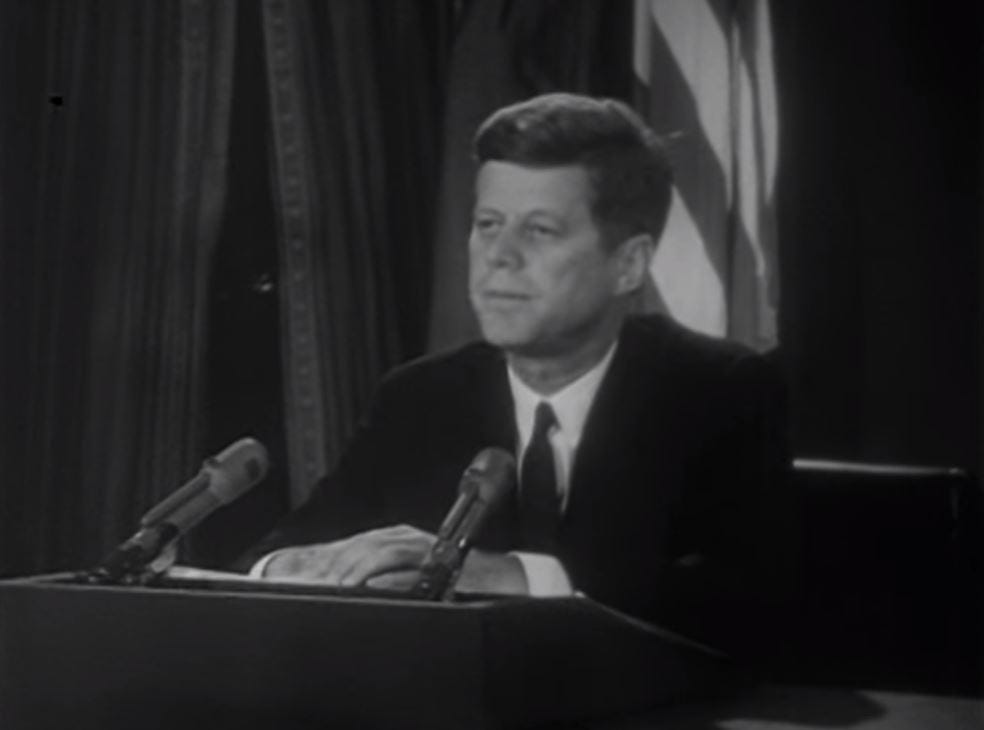On this day in 1962, John F. Kennedy is shown photos of Soviet nuclear missile installations, then under construction in Cuba. Russian missiles just 90 miles from Florida? The days that followed would be tense and came to be known as the Cuban Missile Crisis.
“[T]he world came closest to blowing itself up during thirteen days in October 1962,” historian Arthur M. Schlesinger, Jr. has described. “Two superpowers overarmed with nuclear weapons challenged each other in what could have spiraled so easily into the ultimate catastrophe.”
Would the Cuban Missile Crisis have happened without Fidel Castro? He and his guerrillas overthrew President Fulgencio Batista in the late 1950s. Unfortunately, once Castro was in power, relations with the United States became strained and Cuba aligned itself with the Soviet Union.
The Cold War was then being silently waged, of course, so a Soviet ally in the Western Hemisphere was definitely not welcome. Presidents Eisenhower and Kennedy tried—and failed—to oust Castro, but the failed Bay of Pigs invasion that resulted from that effort only made things worse.
In the meantime, the United States had been establishing missile bases overseas, including one in Turkey. That base was within range of Moscow, which naturally made the Soviets nervous. Their leader, Nikita Khrushchev, began working with Castro to move nuclear missiles to Cuba. He did it secretly, although Castro disagreed with that tactic.
“We had a sovereign right to accept the missiles,” Castro later said. “We were not violating international law. Why do it secretly—as if we had no right to do it? I warned Nikita that secrecy would hand the imperialists the advantage.”
Needless to say, things went badly when the United States discovered what was happening.
On October 14, 1962, two American reconnaissance planes spotted the new missile sites in Cuba. Within a few days, the presence of intermediate-range, nuclear-capable missiles was confirmed. The days that followed were tense. Why would the Soviets move missiles so close to the United States? President Kennedy formed a committee—the so-called Ex Comm—that met every day to address the crisis. U.S. carriers were dispatched to form a blockade around Cuba, preventing the delivery of additional missiles. The Soviets began sending submarines instead.
Making matters worse, Castro shot down an American plane that was flying over Cuba to monitor missile activity. The missile that killed the American pilot had been supplied by the Soviets, although the Soviets had not authorized this particular attack.
The two superpowers seemed to be on the verge of war.
Fortunately, the crisis was averted at the last minute. On October 28, Khrushchev and Kennedy reached an agreement. Soviet missiles would be removed from Cuba. In return, the United States agreed not to invade the island. In a secret side agreement, the United States also agreed to remove its missiles from Turkey.
The calm response of both leaders was invaluable. Kennedy sought to give Khrushchev a graceful way out of the situation. For his part, Khrushchev had ignored some of the crazier suggestions of his own advisors.
Bobby Kennedy later gave credit to his brother for the peaceful resolution that had been achieved: “The 10 or 12 people who had participated in all these discussions were bright and energetic people. We had perhaps amongst the most able in the country, and if any one of half a dozen of them were President the world would have been very likely plunged into catastrophic war.”
It had been a narrow escape.
Sources can always be found on my website, here





I remember those days well Tara I was in high school and like my friends thought the worst would happen , Nuclear War ! Thank you for sharing this bit of history and reminding us of those 13 days ! We all loved JFK and “ Camelot “ of that era . He was our “ Merlin “ wonderful man + POTUS !
This was a good look back in history. I’m concerned what may transpire in the near future as Iran (and others ?) acquire nuclear weapons and the delivery systems necessary to become a regional or worldwide threat. There is a lot of hate and craziness in this world and that’s a scary combination.